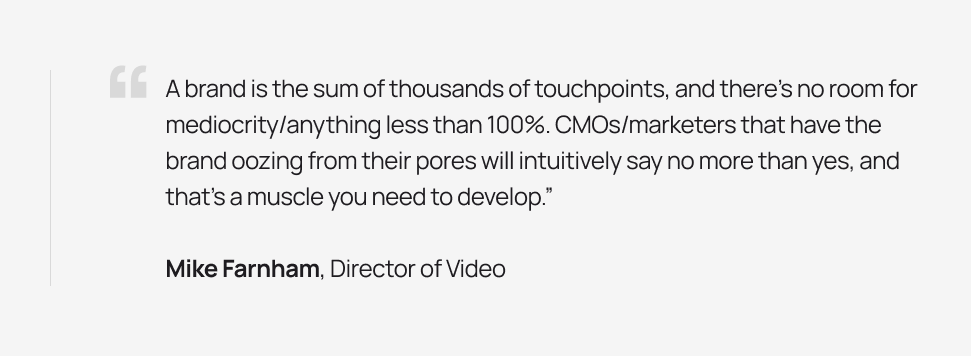In today’s incredibly fast-paced and never-the-same-thing-twice B2B SaaS landscape, leaders face two very real and significant threats—hypocrisy and fear.
Among the thousands of conversations we’ve had with marketers, we’ve noticed a troubling pattern. When asked if they read white papers or company blogs, the answer is almost always “no.” (This was just good for Directive’s content team to know, too.) Yet, when we peek into their company’s LinkedIn ad accounts, a staggering 90% of their paid ads promote the very content they claim not to consume themselves. Riddle me that one, Batman.
Getting to the Root of the Problem
What’s causing this disconnect? It’s pretty simple, actually: blind adherence to “best practices” and an overwhelming yearning for attribution. This is what has stifled marketers’ ability to think creatively and step outside the box. Deep down, B2B marketers know what they should do, but fear holds them back from pitching, persuading, and executing truly remarkable work.
3 Real Solutions for Real Impact (+ a worksheet)
1. Go a mile deep and an inch wide
It’s common knowledge (or it should be), that more marketing activities don’t result in more bookings. The depth of execution is far more critical than ticking off every activity on a checklist—be it Google Ads, Paid Social, Events, or Brand PR. It’s easy to get caught in the whirlwind of tasks, only to celebrate what goes live rather than the creativity and impact behind the efforts.
TAKEAWAY: As Strava co-founder and executive chairman Mark Gainey opines, “Pick a niche, what some people may call too small of an opportunity, and going really deep there; trying to be authentic there, and develop leadership there in the hopes that the opportunity leads to something bigger.”
2. Set your sights higher.
It’s natural to want to avoid pointing out when something isn’t good enough for the brand. If your beloved and seldom-wrong Content team (ahem) just spent months crafting a killer asset, and there’s a push to “get it live”—especially if it’s in response to lead gen being down—you still have to ask yourself, is this enough? Is this the right thing to do? Is good enough, good enough?
The short answer is no.
The long answer is, building a brand should be about creating a market staple, not merely achieving a numerical target. To truly excel, we must set our aspirations high and hold everyone accountable to their creative potential. Remember, great marketing takes a leader willing to say “no” more often than “yes.”
As Directive’s Director of Video, Mike Farnham likes to say, “You need come back to the deeper purpose (brand ethos) and reasons why you are crafting particular assets, and hold that up to a mirror to see if it passes the test before shipping it. “
Mike goes on to say, “A brand is the sum of thousands of touchpoints, and there’s no room for mediocrity/anything less than 100%. CMOs/marketers that have the brand oozing from their pores will intuitively say no more than yes, and that’s a muscle you need to develop. If you are just shipping stuff that meets the minimum, you might have weaker convictions than you think. The best tech marketers don’t settle for ‘B2B’s generic best practices’. Rather, they challenge the norm because they have a distinct POV/conviction.”

3. Don’t just know your product, be immersed in it.
How can you come up with the brilliant ideas to make people care about your product if you aren’t a power user yourself? We do a little exercise here: We immerse ourselves in our service pages, listen in on strategy calls, take the time to understand our clients’ wants and needs, then we look at our brand value propositions. And sometimes, most times, we need to make some marketing shifts. (It happens.) Marketers suffer from a perception problem—we stop engaging with our customers, cease using our own products, and construct narratives disconnected from reality.
TAKEAWAY: Want to try this exercise? It’s pretty fun, tbh. We’ve created a worksheet for you to track your findings:

Make sure you take notes during every “Aha Moment” and then assess whether your marketing effectively communicates these insights to your target audience.
From Hypocrisy and Fear to a Culture of Innovation
If you really, really want to shift the narrative of your B2B SaaS marketing strategy and push past fear, fostering a culture of innovation within your team is paramount. This involves creating an environment where taking risks is encouraged and where failures are viewed as stepping stones rather than setbacks. (Side note: Our leadership at Directive does this a lot, and the results are pretty incredible.) When team members feel safe to propose wild ideas or challenge the status quo, the potential for breakthroughs increases exponentially.
4 Ways to Build a Culture of Innovation
Embrace Experimentation
If encouraged-experimentation is not a part of your marketing initiatives, rethink why. Team members should be applauded for wanting to test new channels, messaging strategies, and content formats. And there should be zero talk of immediate return on investment. Maybe it’s a video series about customer stories or trying unconventional ad placements, recognizing that not every experiment will yield immediate success, you create a space for exploration where creativity flourishes. Remember, some of the most successful marketing campaigns arose from unexpected experiments that initially seemed too risky.
HOW:
Look beyond your industry for inspiration. Brands like Liquid Death, Chubbies, Wendy’s, and Duolingo. They took the “script” and threw it out completely.
As Mike Cessario, CEO of Liquid Death accurately states, “Marketers can be too literal about making sense – there is a tremendous value in confusion. If you can confuse people, you can stop them.”
Celebrate Wins and Learn from Losses
Sometimes it’s better if a marketing campaign fails. It offers very, very clear guidelines on what not to do next time. With that in mind, it’s important to celebrate both successes and failures publicly within your marketing team and beyond. When a team member successfully implements a creative campaign, acknowledge it, share the results, and explore what made it work. Conversely, if an initiative doesn’t perform as expected, facilitate a constructive debrief. What can be learned from the experience? This open dialogue not only solidifies team cohesion, it also fosters a growth mindset, empowering everyone to approach challenges with confidence.
Ultimately, true marketing leadership lies in cultivating an atmosphere where creativity, experimentation, and accountability coalesce, leading to innovative strategies that resonate with your audience. Commit to pushing boundaries, embracing fears, and transforming your brand’s story into something extraordinary.
HOW:

Foster Cross-Disciplinary Collaboration
The most jargoned piece of advice is probably around “breaking down silos” and “cross-collaboration.” However, saying it and implementing it are two wildly different things.
We’ll say it loudly and definitively (for those in the back): Marketing cannot exist in a silo.
Marketing only truly works within collaboration and an integration of diverse perspectives across your company. If you are in charge of a marketing team, next time you meet, encourage your Content team to chat with Sales. Tell your Demand Gen team to talk to IT. Maybe Social Media and HR need a happy hour. Whatever it is, teams need come together, leveraging insights from product development, sales, customer support, management, and beyond, to uncover richer ideas and a more holistic understanding of your market.
HOW:
- Reward collaboration
- Make collaboration part of the employee review process
- Recognize and reward those who work effectively across the organization
- Transparent organizational communication
- Company-wide transparent communication helps break down silos and fosters collaboration.
- Make networking a thing
- Employees with diverse networks within the organization significantly enhance value and promote effective collaboration.
- Maximize the flow of knowledge and information by actively fostering workplace relationships and ensuring that all offsite retreats and workplace events provide enough opportunities for social interaction beyond work
- Employees with diverse networks within the organization significantly enhance value and promote effective collaboration.
- Align around unified goals
- Success hinges on a unified team focused on common objectives and goals. Leaders play a crucial role in understanding and communicating the organization’s overarching goals, emphasizing the need for collaboration across various departments to hit targets.
- Drive innovation through diverse thinking
- Creativity only happens through “collective diversity” — that special blend of POVs from people with varied backgrounds, thought processes, and expertise.
- Prioritize collaborative innovation, leaders can form cross-functional teams that harness these diverse viewpoints to drive breakthrough ideas.
- Creativity only happens through “collective diversity” — that special blend of POVs from people with varied backgrounds, thought processes, and expertise.
- Focus on trust-based relationships
- Collaboration can only exist where trust exists. People must feel confident in others.
- Maintain positive group dynamics to serve as the foundation for collaboration and strong working relationships.
- Collaboration can only exist where trust exists. People must feel confident in others.
Invest in Continuous Learning
Do you know why you never want to be the smartest person in the room? Because, usually that person is a know-it-all that is devoid of taking into account anyone else’s experience, and merely pontificates on what they “know.” But we digress… encourage your team to explore new skills, whether through formal training sessions, online courses, or industry conferences.
Investment in professional development not only equips your team with fresh ideas but also instills a sense of growth and empowerment. When individuals feel supported in their learning journeys, they are more likely to contribute innovative ideas that elevate the entire organization.
HOW:

Final thoughts
While it may not be readily apparent, exceptional marketing requires more backbone than creativity.
What’s the saying? If it’s too loud, you’re too old? Well, same goes for here: if your brand’s marketing doesn’t make you uncomfortable—if you’re not afraid of the work required—then you’re not dreaming big enough. Stop publishing marketing that doesn’t excite you. You should be your biggest fan—and if you are, your audience will be too.
Tell fear and hypocrisy to hit the bricks and get your marketing to a new level.
To being fearless.
-
 Will Price
Will Price
Did you enjoy this article?
Share it with someone!
